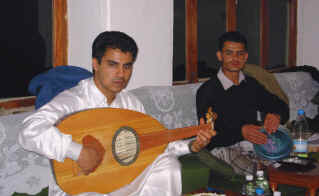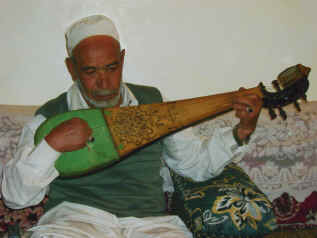 |
| Sound
Training Workshop |
| |
 |
| Hasan al-Ajami |
Safeguarding
the Song of Sana'a: challenges and issues
by Samir
Mokrani
This article is based on an
address to the Society by the author, a musicologist, at
Goodenough College, London, on 23 November 2010
The Song of Sana'a: a brief
introduction
The Song of Sana'a or ghinâ'
san'ânî, is one of the main kinds of Yemeni music. It can
be described as a traditional urban genre, derived from various
poetic traditions dating from the 14th century, which
constitutes an integral part of social events, such as the samra
(night-long wedding celebrations), and the magyal, the
daily afternoon gathering of friends and colleagues at which the
mildly narcotic leaf qat is chewed. Thus, the Song of
Sana'a is a major component of the traditional urban elite's
culture, made up of musicians, poets, writers or just
connoisseurs. More than a kind of music, it represents a whole
micro culture, with its own social codes, aesthetic and vision
of the world.
The ghinâ' san'ânî is
performed by a solo singer who accompanies himself on the Yemeni
lute qanbûs/turbî or the Arabic lute 'ûd. He is
sometimes also accompanied by a traditional copper plate player
(sahn mîmyie/nuhâsî).
The UNESCO Action Plan and
its implementation
Mostly as a result of Jean
Lambert's efforts, the Song of Sana'a was proclaimed by UNESCO
as a Masterpiece of the World Oral and Intangible Heritage of
Humanity in 2003. Dr. Lambert was then in charge of writing an
Action Plan proposal, helped in this task by Sabrina Kadri and
myself; both of us were then trainee researchers at CEFAS (The
French Centre for Archaeology and Social Sciences in Sana'a),
where Jean Lambert had become the new director, and were
studying for our masters. The proposal benefited from a UNESCO/
Japanese Trust Fund which supported the project from 2006 to
2009, in cooperation with the Yemen Social Fund for Development
(SFD), the Ministry of Culture and CEFAS.
It was logical that the Yemeni
Centre for Musical Heritage(YCMH) was chosen as the official
implementing agency of the UNESCO Action Plan, and its director,
Mr. Jaber Ali Ahmed, was appointed as the National Coordinator,
while I was the Administrative and Scientific Coordinator.
The project's activities
encompassed the following:
- preparation and development
of an inventory of the Song of Sana'a;
- establishment of archives
within the institutional infrastructure of the YCMH and the
training of researchers in the techniques of field survey
and data collection;
- encouraging the transmission
of the Song of Sana'a, through the establishment of master
classes and scholarships for students;
- preservation of the musical
instruments through lute-making workshops, with scholarships
for students;
- awareness-raising campaign
and dissemination of recordings, together with the
production of promotional documentation such as CDs, DVDs
and books.
Mixed results: Issues and
problems faced by the executive team
The archiving constituent can
be considered as a success, as we managed to build a computer
database with more than 300 melodies. We also released an
official CD of archive recordings, and a history of the Song of
Sana'a is due to be published in a few months. However, the
results we obtained concerning the other aspects of the project,
namely the recording of living masters and musicians, and the
setting up of musical and instrument making skills transmission
workshops were much less positive, and this for the reasons that
are discussed below. Thus, we only managed to record a group of
traditional religious chanters (munshidîn or nashshâdîn)
and two living masters of the Song of Sana'a. On the
transmission side, the musical workshops were, to be honest, a
complete failure, while only two young men benefited to a
certain degree from the lute making workshops.
Work & personal
relations
First of all, and as a
preliminary remark, I would like to explain my personal
position. When I was appointed as the Administrative and
Scientific Coordinator, I built up a close friendship with two
men who were supposed to play a major role in the transmission
activities, namely the lute maker Fu’ad al-Qu’turî and the
master singer Hasan al-‘Ajamî. Up to a point, I was even
considering the latter as my master for learning the very
demanding tradition of the Song of Sana'a, as I had spent
several hours at his house singing, learning and chewing qât.
Unfortunately, I discovered that these personal links made
things much more complicated, particularly in regard to
financial matters, than if I had been an outsider;
unfortunately, my relations with these two men changed
considerably.
Music and musicians in
Yemen, a still ambiguous status
As to the failure of the
recording and the transmission activities, it is clear that the
still negative status of music and musicians in Yemeni society
played a major part. The dubious moral reputation of musicians
is partly due to religious factors (the Zaydi Imamate was always
quite strict on this issue), but also to a code of honour
related to the tribal social organisation specific to Yemen,
which, in our case, had direct consequences: the musician who
can be considered the last real traditional qanbûs player
and singer simply refused to be recorded or teach his music to
young musicians. For him, it was not music in itself that
appeared to be the cause of the problem, but his appearance in
public as a musician. He once told me an anecdote, which,
despite the fact that it relates to 20 years ago, is still
relevant today: ‘My father once told me: my son, this music
which I play and which my father played before me and his father
before him is a treasure, and I would be glad to teach it to
you. But if I hear that you have played it outside the house, I
will kill you!’
Transmission and competition
Regarding the tradition of lute
making, we were confronted with a very practical problem. Mr. Fu’ad
al-Qu‘turî (al-Gudaymî), identified as the last of the
old-style Yemeni lute makers, was quite happy when he first
heard that our project would support him by employing him as a
lute-making teacher. But after a while, as he considered that
the amount we could pay him for teaching was not enough, he told
me: ‘OK, if I teach three or four young people, then they will
be able to make turbî by themselves … and to sell them
as well. So in the long term, they will become competitors to my
own business … No, the only solution is that you pay me a big
amount in compensation for revealing my skills.’ Here we can
see all the dilemmas and limitations of our project.
Yemen, social changes and
globalization: an evolution of musical tastes
As a matter of fact and like
most traditional societies in the world, Yemen has been facing
huge socio-cultural changes for about 30 years, with a
particular peak in the urban areas from the 90's up to now.
These violent upheavals, of course, also occurred in the musical
field, resulting in notable changes in the younger generation's
musical tastes. Anyone who has spent some time in Sana'a, Aden,
Taiz or any other urban area in Yemen would immediately notice
that many young people, let us say between 10 and 40 years old,
frequently listen to Lebanese, Egyptian or Khalîjî
(Gulf) pop music. Certainly, this phenomenon increased with the
spread of television and more general use of the internet.
Despite this, however, local
musical styles still seem to enjoy quite a large success, with a
well-defined variety of characteristics or "colours" (alwan)
according to the person's origins and/or the place where he was
born and grew up. As for the Song of Sana'a, I would say that
the issue is much more related to the internal formal changes
that happened in the repertoire itself. What I mean here is that
the ghinâ’ san‘ânî that is sung today is not the
same as the one former generations used to listen to. From a
highly sophisticated music that can almost be compared to a kind
of initiatory tradition, it has become a popular music. The best
example is the adoption of the large Arabic ‘ûd in
place of the earlier, smaller qanbûs/turbî.
Thus, many young Yemenis told me: ‘Yes, the turbî is
nice, but the ‘ûd sounds stronger and better …’
Conclusion
It seems obvious that the
global conditions now confronting the Song of Sana'a are
unlikely to favour its preservation. However, although the
implementation of our Action Plan has been unable to avoid the
Song's progressive disappearance, the process has at least
stimulated a debate, and opened up new opportunities for action.
But only a genuine political will on behalf of those concerned
among the Yemeni authorities will achieve a real safeguarding
and promotion of this unique tradition.
Vol 19. 2011
 |
| Samir
and Marwan, trainee musicians |
| |
 |
| Muhammad
al-Juma |
| |
 |
| Fuad
al-Qu'turi, Sana'a instrument maker, working on a qanbus |
|
